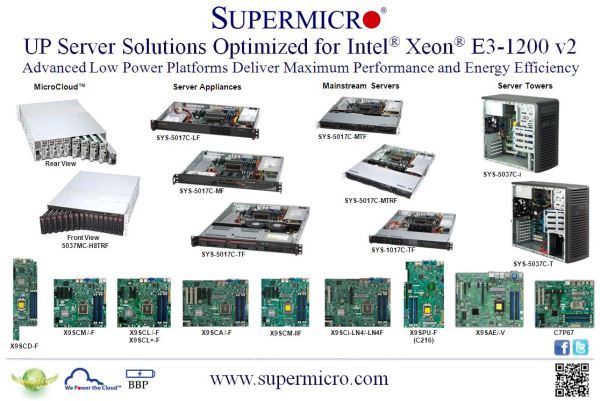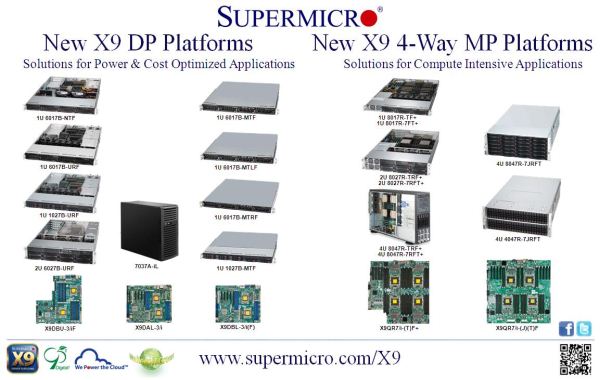Supermicro Updates X9 Platform for Intel's Latest Xeon Families
by Ganesh T S on May 23, 2012 1:59 PM EST- Posted in
- IT Computing
- Supermicro
Intel introduced three new Xeon processor families last week. The Xeon E3-1200 v2 family is based on the Ivy Bridge architecture, while the Sandy Bridge based Xeon E5-2400 and E5-4600 families encompass processors for two and four socket systems respectively. Supermicro has duly updated their X9 family of motherboards and systems to support the new processors. Without further digression, let us take a look at their new products.
Ivy Bridge Xeon Platforms
The updates for the Ivy Bridge Xeons has been quite straightforward for Supermicro. In fact, the announcements actually link to boards / systems based on the Sandy Bridge Xeons (E3-1200), along with a BIOS update for PCI-E 3.0 support.
This 3U 8x node 'MicroCloud' system is meant for cloud computing, data center and web hosting applications. Each node can support two hot-swap SATA3 disks and upto 32 GB of ECC memory. It is based on the Intel C204 PCH chipset and has two GbE ports courtesy of the Intel 82580DB. The support for the Xeon E3-1200 v2 family starts from BIOS rev. 2.0 (with support for DDR3-1600 and PCI-E 3.0 connection speeds for the single PCI-E x8 slot).
These 1U rackmount servers are meant for networking and embedded applications. The TF model is based on the C204 PCH chipset (Supermicro's X9SCM-F motherboard), while the other two are based on the C202 (X9SCL-F motherboard). The differences between the units are mainly with respect to the SATA disk support
and the nature of the PCI-E cards which can be added on. While the LF model supports 1x3.5" or optional 2x2.5" internal SATA drive bays and 1x PCI-E 3.0 x8 low profile slot, the MF model supports 2x3.5" internal HDDs and the PCI-E 3.0 slot is full height. The TF model supports full height / full length PCI-E cards in the PCI-E 3.0 slot and also includes support for hot swapping the hard drives in the two internal bays.
5017C-MTF, 5017C-MTRF, 1017C-TF:
These 1U rackmount mainstream server systems are meant for gateway / security / DVR / transcoding and broadcast applications. All of them are based on Supermicro's X9SCL-F motherboard with the C602 PCH chipset. The TF model has RAID support for the 4x2.5" hot-swap SATA2 HDDs, while the other two models support 4x3.5" hot-swap drives without RAID. All three models have full height PCI-E slots (PCI-E 3.0 x8), but
only the TF model can support full-length cards. All models have support for up to 32 GB of ECC memory, two GbE LAN ports and 6x SATA 2.0 ports with RAID 0,1,5,10 support. The MTF model comes with a 350W power supply while the TF model has a 330W one. The MTRF has a redundant power supply with a rating of 400W.
These are server towers for small/medium business applications, file/storage serving and remote desktop applications. While the i model is based on Supermicro's X9SCL motherboard, the T model is based on the X9SCA. Both of them support upto 32 GB of ECC DRAM (upto DDR3-1600). The T model comes with a 500W power supply, support for 4x3.5" internal SATA HDDs and an optional 4x2.5" rotatable HDD cage. There are 2 GbE ports. The PCI breakdown is as follow: 1 PCI-E 3.0 x16, 2 PCI-E 2.0 x4 in x8 and 3 PCI 32-bit expansion slots. The i model has a 300W power supply, with support for 2x5.25" external drive bays, 4x3.5" internal drive bays and 1x3.5" external drive bay (with the hard drive cage capable of rotation for easy access). There are 2 GbE ports, just like the T model. The PCI break down is as follows: 2 PCI-E 3.0 x8 and 1 PCI-E 2.0 x4 in x8 slot.
The motherboards of all the above systems are also available stand-alone for system integrators and resellers to build their own custom machines.
Sandy Bridge-EN and Sandy Bridge-EP Xeon Platforms
Supermicro also updated their X9 lineup to include boards for the Xeon E5-2400 (Sandy Bridge-EP) and Xeon E5-4600 (Sandy Bridge-EN) dual and quad processor families.
The X9 Dual-Processor (DP) solutions cater to date centers, web servers, search engine appliances, gaming systems and ATMs. The 4-way Multi-Processor (MP) platforms target high-end enterprise IT and high performance computing (HPC) applications.
The DP solutions include systems based on the following motherboards:
X9DBU-3/iF: The 3F model is based on the C606 chipset, while the iF model is based on the C602. While the 3F model supports 4xSATA2, 2xSATA3 and 8xSAS, the iF model supports 8xSATA2 and 2xSATA3 only. Both of the boards support upto 384 GB of ECC memory. PCI-E support includes 1x v3.0 x24 and 1x v3.0 x8. The form factor is proprietary. Supermicro has one 2U rackmount system (6027B-URF) based on the 3F model. The 1U systems include 1027B-URF, 6017B-URF and 6017B-NTF.
X9DAL-3/i: These motherboards support upto 192 GB of ECC memory. The 3 model is based on the C606 chipset, and the i model is based on the C602. Both of them support one PCI 32, one PCI-E 3.0 x16, 1 PCI-E 3.0 x4 (in x8) and one PCI-E 3.0 x8 (in x16) and two PCI-E 3.0 x8. The SATA/SAS configuration difference stems from the differences between the C606 and C602 chipset and are the same as that of the X9DBU model. The i model is at the heart of the 7037A-iL mid-tower workstation.
X9DBL-3/i(F): The 3 models are based on the C606 chipset, while the i models are based on the C602. As usual, the C606 brings along with it support for 8x SAS/SATA ports. The i models also have integrated IPMI 2.0 and KVM along with a dedicated LAN. All of the models support upto 192 GB of ECC memory, and the expansion slots include one PCI, three PCI-E 3.0 x8, one PCI-E 3.0 x16 and one PCI-E 3.0 x4 (in x8). These motherboards have been put in a range of 1U rackmount servers including the 6017B-MTF, 6017B-MTLF, 6017B-MTRF and 1027B-MTF.
The 4-way MP solutions include systems based on the following motherboards:
X9QR7/i-(T)F+: Systems based on these motherboards include the 1U 8017R-TF+ and 7FT+, the 2U 8027R-TRF+ and 7RFT+ and the 4U 8047R-TRF+ and 7RFT+. These are based on the C602 chipset and can support upto 32 DIMMs for 1 TB of ECC memory. There are four PCI-E 3.0 x16 (out of which two operate in x8 mode) slots. All models have dual GbE LAN, but the T SKU has dual 10 GbE capability. There are 8 SAS2 ports courtesy of the LSI 2208 in the "7" SKU in this 16.79" x 16.4" board.
X9QR7/i-(J)(T)F: Systems based on these motherboards include the 4U 8047R-7JRFT and the 4U 4047R-7JRFT. Compared to the "+" motherboards detailed above, these support only 24 DIMMs for a total of 768 GB of ECC memory. There are 8 PCI-E 3.0 x16 (one of them operates in x8 mode) slots, and dual 10 GbE capability comes as a standard. LSI 2308 provides 16 SAS2 ports for this 17" x 17" board.
Source: Supermicro












5 Comments
View All Comments
mac_savant - Wednesday, May 23, 2012 - link
I see Anandtech and others covering the E5-2400 and products based on them, but no one's really covered what the differences are between the E5-2400 series and the E5-2600 series.From all the specs on Intel's site and other details I can find, I can't see what the point of the E5-2400 series is. They're almost identical specs, a couple percent cheaper and use a new socket.
Someone please tell me what I'm missing.
Duraz0rz - Wednesday, May 23, 2012 - link
The E5-2670 has two QPI links (for a max of 51.2GB/s memory bandwidth) and supports 750GB of memory.The E5-2470 has only one QPI link (for a max of 38.4GB/s) and only supports 375GB of memory.
The 2670 is also SB-EP based, while the 2470 is SB-EN based.
mac_savant - Thursday, May 24, 2012 - link
So the E5-2400 series is inferior to the E5-2600 series, but the price is virtually the same. I don't know what the difference is between EP and EN, but I figured that Sandy Bridge is Sandy Bridge. I still don't understand the point of the E5-2400 series.DanNeely - Thursday, May 24, 2012 - link
It's a question of the socket used. EN uses the cheaper LGA 1356 socket, EP LGA 2011. 1 QPI link vs 2, 24 PCIe lanes vs 40, and 3 ram channels vs 4. Both the 2400 and 2600 appear to be dual socket only, with quad being limited to the 4600 series parts.wishgranter - Thursday, May 24, 2012 - link
Hello guys @Anand, im hoping that you will test it as soon as possible for us.